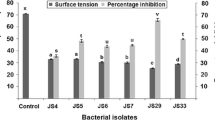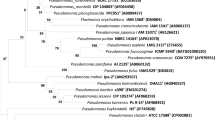Abstract
The use of biosurfactants is a promising alternative in biological control of zoospore-producing oomycetes, which are a major plant pathogen world-wide in a wide variety of crops. Oomycetes are of particular concern in closed hydroponic cultivation systems. The present study investigated the efficacy of a biosurfactant produced by Pseudomonas koreensis and added as a crude extract against the oomycete Pythium ultimum in hydroponic tomato cultivation. A significant reduction in disease was observed. Biosurfactant addition did not affect the indigenous root microflora when evaluated as sole carbon source utilisation. Chemical analysis, using electrospray hybrid mass spectrometry (ESI-MSMS), of the biosurfactant indicated it to be lokisin, a cyclic lipopeptide. These results confirm that biosurfactants are important in developing sustainable biological control strategies for oomycetes.




Similar content being viewed by others
References
Barros FFC, Ponezi AN, Pastore GM (2008) Production of biosurfactant by Bacillus subtilis LB5a on a pilot scale using cassava wastewater as substrate. J Ind Microbiol Biotechnol 35:1071–1078
De Jonghe K, De Dobbelaere I, Sarrazyn R, Höfte M (2005) Control of Phytophthora in the hydroponic forcing of witloof chicory with the rhamnolipid-based biosurfactant formulation PRO1. Plant Pathol 54:219–226
De Souza JT, De Boer M, De Waard P, van Beek TA, Raaijmakers JM (2003) Biochemical, genetic, and zoosporicidal properties of cyclic lipopeptide surfactants produced by Pseudomonas fluorescens. Appl Environ Microbiol 69:7161–7172
Domenech J, Reddy MS, Kloepper JW, Ramos B, Gutierrez-Manero J (2006) Combined application of the biological product LS213 with Bacillus, Pseudomonas or Chryseobacterium for growth promotion and biological control of soil-borne diseases in pepper and tomato. BioControl 51:245–258
Ehret DL, Alsanius B, Wohanka W, Menzies JG, Utkhede R (2001) Disinfection of recirculating nutrient solution in greenhouse horticulture. Agronomia 21:323–339
Francis DM, St Clair DA (1997) Population genetics of Pythium ultimum. Phytopathology 87:454–461
Garland JL, Mills AL (1991) Classification and characterization of heterotrophic microbial communities on the basis of patterns of community-level sole-carbon-source utilization. Appl Environ Microbiol 57:2351–2359
Gravel V, Martinez C, Antoun H, Tweddel RJ (2005) Antagonistic microorganisms with the ability to control Pythium damping-off of tomato seeds in rockwool. BioControl 50:771–786
Haas D, Defago G (2005) Biological control of soil-borne pathogens by fluorescent pseudomonads. Nat Rev Microbiol 3:307–319
Hultberg M, Bergstrand KJ, Khalil S, Alsanius B (2008) Characterization of biosurfactant-producing strains of fluorescent pseudomonads in a soilless cultivation system. Antonie van Leeuwenhoek 94:329–334
Judelson HS, Blanco FA (2005) The spores of Phytophthora: weapons of a plant destroyer. Nat rev 3:47–58
Khalil S (2001) Microflora in the root environment of hydroponically grown tomato: Methods for assessment and effects of introduced bacteria and Pythium ultimum. PhD Thesis, Swedish University of Agricultural Sciences. Agraria 263
Klasson KT (1997) Experimental data analysis: An algorithm for smoothing of data and determining enzyme and microbial kinetic rates. Appl Biochem Biotechnol 63(65):339–348
Klasson KT (2008) Construction of spline functions in spreadsheets to smooth experimental data. Adv Eng Software 39:422–429
Kwon SW, Kim JS, Park IC, Yoon SH, Park DH, Lim CK, Go SJ (2003) Pseudomonas koreensis sp. nov., Pseudomonas umsongensis sp. nov. and Pseudomonas jinjuensis sp. nov., novel species from farm soils in Korea. Int J Syst Evol Microbiol 53:21–27
Mulligan CN (2005) Environmental applications for biosurfactants. Environ Poll 133:183–198
Nielsen TH, Sørensen D, Tobiasen C, Andersen JB, Christophersen C, Givskov M, Sørensen J (2002) Antibiotic and biosurfactant properties of cyclic lipopeptides produced by fluorescent Pseudomonas spp. from the sugar beet rhizosphere. Appl Environ Microbiol 68:3416–3423
Nielsen CJ, Ferrin DM, Stanghellini ME (2006) Efficacy of biosurfactants in the management of Phytophthora capsici on pepper in recirculating hydroponic systems. Can J Plant Pathol 28:450–460
Oberbremer A, Müller-Hurtig R, Wagner F (1990) Effect of the addition of microbial surfactants on hydrocarbon degradation in a soil population in a stirred reactor. Appl Microbiol Biotechnol 32:485–489
Ojiambo PS, Scherm H (2006) Biological control and application-oriented factors influencing plant disease suppression by biological control: A meta-analytical review. Phytopathology 96:1168–1174
Paulitz TC (1997) Biological control of root pathogens in soilless and hydroponic systems. Hort Sci 32:193–196
Perneel M, D′hondt L, De Maeyer K, Adiobo A, Rabaey K, Höfte M (2008) Phenazines and biosurfactants interact in the biological control of soil-borne diseases caused by Pythium spp. Environ Microbiol 10:778–788
Prescott LM, Harley JP, Klein DA (2005) Microbiology, 6th ed. The McGraw-Hill Companies Inc., N.Y., USA
Rafin C, Tirilly Y (1995) Characteristics and pathogenicity of Pythium spp. associated with root rot of tomatoes in soilless culture in Brittany, France. Plant Pathol 44:779–785
Sheppard JD, Mulligan CN (1987) The production of surfactin by Bacillus subtilis grown on peat hydrolysate. Appl Microbiol Biotechnol 27:110–116
Siegmund I, Wagner F (1991) New method for detecting rhamnolipids excreted by Pseudomonas species during growth on mineral agar. Biotechnol Tech 5:265–268
Sobrinho HBS, Rufino RD, Luna JM, Salgueiro AA, Campos-Takaki GM, Leite LFC, Sarubbo LA (2008) Utilization of two agroindustrial by-products for the production of a surfactant by Candida sphaerica UCP0995. Process Biochem 43:912–917
Sørensen D, Nielsen TH, Sørensen J, Christophersen C (2002) Cyclic lipoundecapeptide lokisin from Pseudomonas sp. strain DSS41. Tetrahedron Lett 43:4421–4423
Stanghellini ME, Miller RM (1997) Biosurfactants: Their identity and potential efficacy in the biological control of zoosporic plant pathogens. Plant Dis 81:4–12
Stanghellini ME, Rasmussen SL (1994) Hydroponics- a solution for zoosporic pathogens. Plant Dis 78:1129–1138
Tran TTH (2007) Interactions between biosurfactant-producing Pseudomonas and Phytophthora species. PhD Thesis. Wageningen University. The Netherlands
Tran H, Kruijt M, Raaijmakers JM (2008) Diversity and activity of biosurfactant-producing Pseudomonas in the rhizosphere of black pepper in Vietnam. J Appl Microbiol 104:839–851
U.S. EPA (2004) Pesticides: Rhamnolipid biosurfactant (110029) Fact Sheet. http://www.epa.gov/pesticides/biopesticides/ingredients/factsheets/factsheet_110029.htm
Van Hamme JD, Singh A, Ward OP (2006) Physiological aspects, Part 1 in a series of papers devoted to surfactants in microbiology and biotechnology. Biotechnol Adv 24:604–620
van West P, Appiah AA, Gow NAR (2003) Advances in research on oomycete root pathogens. Physiol Mol Plant Pathol 62:99–113
Zhang Y, Miller RM (1992) Enhanced octadecane dispersion and biodegradation by a Pseudomonas rhamnolipid surfactant. Appl Environ Microbiol 58:3276–3282
Acknowledgments
This study was supported by a grant from the Swedish Research Council for Environment, Agricultural Sciences and Spatial Planning (FORMAS). We are grateful to Dr. J.M. Raaijmakers for his help in the initial work concerning the chemical identification of the biosurfactant. We also wish to thank Dr. T.K. Klasson for his help with data analysis.
Author information
Authors and Affiliations
Corresponding author
Additional information
Handling Editor: Monica Höfte.
Rights and permissions
About this article
Cite this article
Hultberg, M., Alsberg, T., Khalil, S. et al. Suppression of disease in tomato infected by Pythium ultimum with a biosurfactant produced by Pseudomonas koreensis . BioControl 55, 435–444 (2010). https://doi.org/10.1007/s10526-009-9261-6
Received:
Accepted:
Published:
Issue Date:
DOI: https://doi.org/10.1007/s10526-009-9261-6




